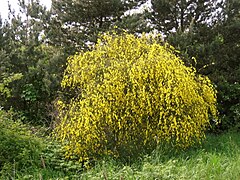Cytisus scoparius
| Cytisus scoparius | |
|---|---|

| |
| Scientific classification | |
| Kingdom: | |
| Division: | |
| Class: | |
| Order: | |
| Family: | |
| Genus: | |
| Species: | C. scoparius
|
| Binomial name | |
| Cytisus scoparius | |
| Synonyms | |
|
Spartium scoparium L. | |
Cytisus scoparius (Common Broom; syn. Sarothamnus scoparius) is a perennial, leguminous shrub native to western and central Europe from the Iberian Peninsula north to the British Isles and southern Scandinavia, and east to Poland and Romania,[1] where it is found in sunny sites, usually on dry, sandy soils at low altitudes[2].
It typically grows to 1-3 m tall, rarely 4 m, with main stems up to 5 cm thick, rarely 10 cm. It has green shoots with small deciduous trifoliate leaves 5-15 mm long, and in spring and summer is covered in profuse golden yellow flowers 20-30 mm from top to bottom and 15-20 mm wide. Flowering occurs after 50-80 growing degree days. In late summer, its legumes (seed pods) mature black, 2-3 cm long, 8 mm broad and 2-3 mm thick; they burst open, often with an audible crack, spreading seed from the parent plant. It is the hardiest species of broom, tolerating temperatures down to about -25°C.[2][3][4]
There are two subspecies[1][2]:
- Cytisus scoparius subsp. scoparius. Throughout the species' range.
- Cytisus scoparius subsp. maritimus (Rouy) Heywood. Western Europe, on maritime cliffs. Differs in prostrate growth, not over 0.4 m tall, and downy young shoots.
In Britain and Ireland the standard name is Broom,[5][2][4] but this name is also used generically for other related species (see broom), and the term Common Broom is sometimes used for clarification[6][7]. In other English-speaking countries, the most prevalent common name is Scotch Broom [8]; English Broom is also occasionally used (see Scotch and England).
Cultivation and naturalisation
It is widely cultivated as an ornamental plant, with several cultivars selected for variation in flower colour, including 'Moonlight' with deep yellow flowers, 'Andreanus' and 'Firefly' with dark orange-red flowers, and growth habit, including 'Pendula' with pendulous branchlets.[3]
It has been naturalized into several continents outside its native range, where it is sometimes regarded as a noxious invasive species in some places such as California and the Pacific Northwest in North America, Australia and New Zealand. The prolific growth of this species after timber harvest inhibits reforestation by competing with seedling trees.[9] Oregon estimates that it is responsible for $47 million in lost timber production each year in that state.[10] Some attempts have been made to develop biological controls in affected areas, using three broom-feeding insects, the psyllid Arytainilla spartiophylla, the beetle Bruchidius villosus, and a moth Leucoptera spartifoliella.[11]
-
Close-up of flowers
-
Illustration
-
As an invasive species in the United States
References
- ^ a b Flora Europaea: Cytisus scoparius
- ^ a b c d Blamey, M. & Grey-Wilson, C. (1989). Flora of Britain and Northern Europe. Hodder & Stoughton. ISBN 0-340-40170-2.
- ^ a b Bean, W. J. (1970). Trees and Shrubs Hardy in the British Isles. John Murray, London. ISBN 0-7195-1790-7
- ^ a b Vedel, H. & Lange, J. (1960). Trees and bushes. Metheun, London.
- ^ Botanical Society of the British Isles (zip file)
- ^ Wild Flowers of the Loch Lomond and Trossachs National Park, Scotland
- ^ Garden World: common broom
- ^ National Park Service: Scotch Broom
- ^ "Invasive Plant Species Management Plan" (PDF). McDonald-Dunn Forest Plan, Appendix 7. Oregon State University, College of Forestry. Retrieved 2006-12-20.
{{cite web}}: Cite has empty unknown parameter:|coauthors=(help); line feed character in|work=at position 28 (help) - ^ "Scotch broom". ODA Plant Division, Noxious Weed Control. Retrieved 2006-09-03.
{{cite web}}: Cite has empty unknown parameter:|coauthors=(help) - ^ CSIRO: Biological control



